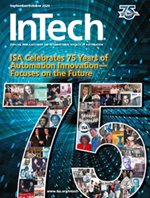
A practical history
ISA is celebrating 75 years as the leading authority in automation. As an ISA Fellow for 15 years, I offer the following comments about the past and future of measurement, communication, and standards.
The process under control can be very simple (i.e., opening a door or setting the temperature in a kitchen oven) or complex, with multivariable matrix optimized functions (i.e., crude oil refinery production flow and temperature controllers). ISA has been involved in making all these systems run at peak performance with high levels of reliability, availability, and safety.
Measurement. Some things have changed over the past 75 years, while others are surprisingly still very much the same. Flow measurement continues to use a handful of technologies. Orifice plates, venturi, vortex, and turbine meters are still the primary meters applied in oil refineries. More recently, some applications have been improved with the application of Coriolis, ultrasonic, and magnetic meters.
Looking to the future, it is likely that flow will continue to be considered a primary variable worth measuring. However, it could be that more and more flow information will be available using simulation and modeling to provide the missing information when a direct measurement is not available. No simple flowmeter exists for applications of two-phase flow; therefore, it is generally estimated using simulation. Direct measurement requires an elaborate system to separate the two phases and measure them.
Similar situations exist with pressure, level, and temperature measurements. Using simple physics-based applications and translating the reading to a primary process variable within a transmitter to communicate the variable is now accomplished with a microengineered mechanical system (MEMS). This has improved the accuracy, reliability, and other performance characteristics of these devices. A continued focus on key performance characteristics, along with lower power and weight, will continue. The other changes have been to move in concert with changes in the communication protocol used by automation systems.
Communication. ISA has been leading the evolution of the communication protocol for the past 75 years. Pneumatic controllers were very common in 1945. Many significant advances have occurred. These will continue, while moving toward a fully wireless communication world. Information can now be delivered anywhere on the planet virtually instantaneously. The problem used to be how to communicate the most recent information to the control system, and now the focus is how to only communicate the required information. Alarm overload is also a prominent area of communication problems for operators in 2020. As more and more applications are available from the cloud or some other virtual location, personalizing the delivery of information is a key area to establish best practices. This will enable the receiving party to easily take any action required—even if it is to do nothing.
Standards. ISA is a leading authority in the area of personalized data on many fronts. ISA symbology makes it very simple to share the process requirements between the system design and the end user. These symbols are then easily translated to the human-machine interface (HMI). In 1945, these were likely vista-green wall boards of the process with the single loop controllers embedded in the wall. Now the display could be a heads-up image that is nearing the holograms of Star Wars and other popular cultural views of the future.
As with many things done by ISA, symbology is backed by many different publications and ISA standards. The standards available from ISA cover alarms, safety applications, control valves, communications, cybersecurity, and many other topics. These standards provide an abundance of information. The addition of specification documents to focus the information flow from designer to vendor and end user is another area for ISA to celebrate as a beneficial achievement.

James W. Harris, ISA Fellow (2005)



